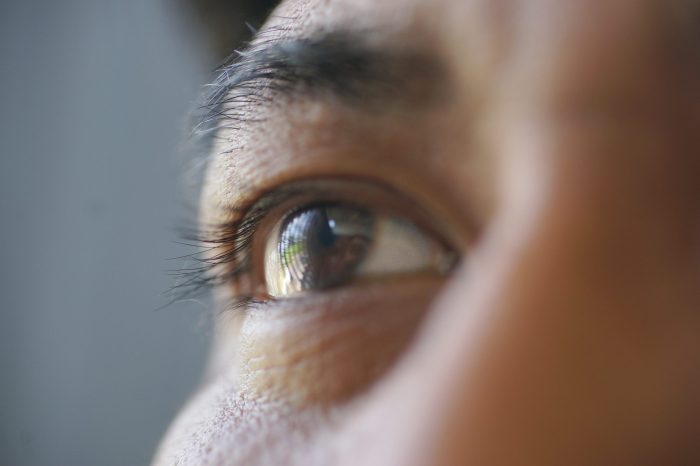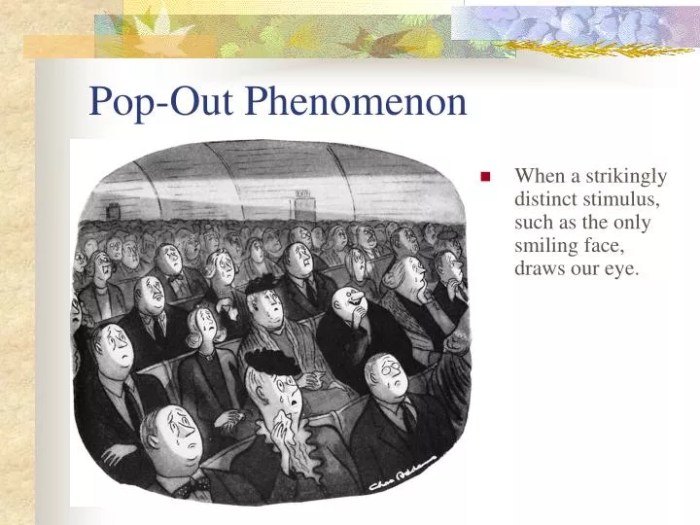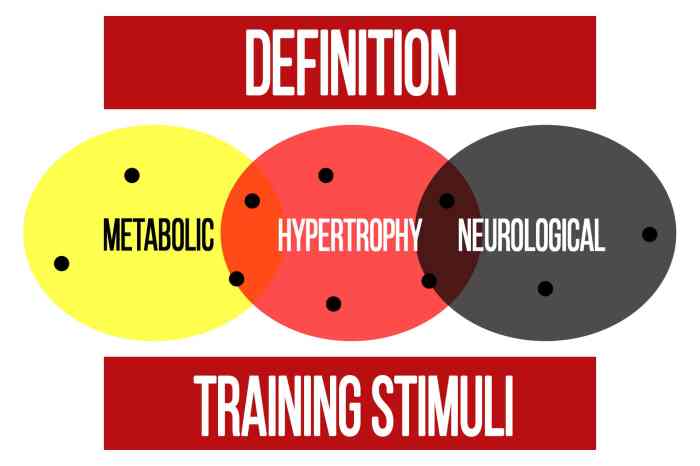The pop-out phenomenon illustrates that some stimuli almost inevitably trigger an immediate and effortless response, capturing our attention and standing out from the visual clutter. This phenomenon plays a crucial role in our perception, guiding our visual search and enabling us to navigate our environment efficiently.
At the heart of the pop-out effect lies the ability of the visual system to prioritize salient features, such as color, shape, and motion. When these features are presented in a contrasting manner against the background, they create a perceptual advantage, making them pop out and attracting our attention almost effortlessly.
Definition of the Pop-Out Phenomenon

The pop-out phenomenon refers to the rapid and effortless detection of a salient or distinctive stimulus within a visual field. It occurs when a stimulus stands out from its surroundings based on its unique visual characteristics, such as color, shape, orientation, or motion.
The pop-out effect is a fundamental aspect of visual perception and allows us to quickly identify and prioritize relevant information in our environment. It plays a crucial role in visual search tasks, attentional processes, and object recognition.
Visual Characteristics Triggering Pop-Out
- Color contrast: Stimuli with high color contrast, such as a red object among green objects, tend to pop out.
- Shape: Objects with unique or unusual shapes, such as a square among circles, can trigger the pop-out effect.
- Orientation: Stimuli with orientations that differ from the surrounding elements, such as a vertical line among horizontal lines, are more likely to pop out.
- Motion: Moving objects often stand out against a stationary background, triggering the pop-out effect.
Neural Mechanisms of the Pop-Out Phenomenon

The pop-out phenomenon is primarily mediated by the visual cortex in the brain. When a salient stimulus is presented, the neurons in the visual cortex responsible for processing that particular feature become highly active.
These neurons form a strong signal that is then relayed to higher-level brain areas, such as the parietal cortex, which is involved in attentional processes. This strong signal triggers a rapid and involuntary shift of attention towards the pop-out stimulus.
Applications of the Pop-Out Phenomenon
The pop-out phenomenon has numerous applications in various fields:
Design and User Interfaces
- Highlighting important information or elements in user interfaces, such as buttons or navigation menus.
- Creating visually appealing designs that draw attention to specific areas.
Visual Search and Detection
- Improving the efficiency of visual search tasks, such as finding a specific object in a cluttered scene.
- Developing detection systems for objects or anomalies, such as in security or medical imaging.
Attention and Distraction
- Understanding how visual saliency affects attention and distraction.
- Designing environments that minimize distractions and enhance attention.
Limitations and Exceptions to the Pop-Out Phenomenon
While the pop-out phenomenon is a robust effect, it can be influenced by certain factors:
Contextual Factors
The context in which a stimulus is presented can affect its saliency. For example, a red object may not pop out if it is surrounded by other red objects.
Attentional Load, The pop-out phenomenon illustrates that some stimuli almost inevitably trigger
When attentional resources are limited, the pop-out effect may be reduced. For example, if an individual is engaged in a demanding cognitive task, they may be less likely to notice a pop-out stimulus.
Stimulus Complexity
The complexity of the visual scene can also affect the pop-out effect. In highly cluttered or complex scenes, it may be more difficult to detect a pop-out stimulus.
Comparisons with Other Visual Phenomena

The pop-out phenomenon shares similarities with other visual phenomena, but also has distinct characteristics:
Illusory Contours
Illusory contours are perceived contours that are not physically present in the image. They are often created by the brain’s tendency to fill in missing information. Unlike pop-out stimuli, illusory contours do not require a physical difference between the stimulus and its surroundings.
Motion Perception
Motion perception involves the detection of moving objects in the visual field. While both motion perception and the pop-out phenomenon involve the detection of salient stimuli, motion perception is specifically tuned to detect movement, whereas the pop-out effect can be triggered by any salient visual feature.
Object Recognition
Object recognition involves the identification of objects based on their shape, color, and other features. While the pop-out phenomenon can facilitate object recognition by drawing attention to salient features, it is a distinct process that occurs at a lower level of visual processing.
Future Directions and Research Questions: The Pop-out Phenomenon Illustrates That Some Stimuli Almost Inevitably Trigger
Ongoing research on the pop-out phenomenon aims to:
- Explore the neural mechanisms underlying the pop-out effect in greater detail.
- Investigate the role of attention and context in modulating the pop-out phenomenon.
- Develop new applications of the pop-out phenomenon in fields such as design, human-computer interaction, and medical imaging.
Clarifying Questions
What are the key characteristics of stimuli that trigger the pop-out effect?
Stimuli that trigger the pop-out effect typically exhibit high contrast in features such as color, shape, or motion, making them stand out from the surrounding background.
How does the brain prioritize salient features in the visual field?
The brain utilizes specialized neural pathways and brain regions to rapidly detect and enhance the processing of salient features. These pathways prioritize the processing of these features, allowing them to capture our attention more easily.
What are some real-world applications of the pop-out phenomenon?
The pop-out phenomenon has practical applications in various fields, including design (e.g., creating visually appealing interfaces), visual search (e.g., detecting targets in cluttered environments), and attention research (e.g., studying the factors that influence attentional capture).